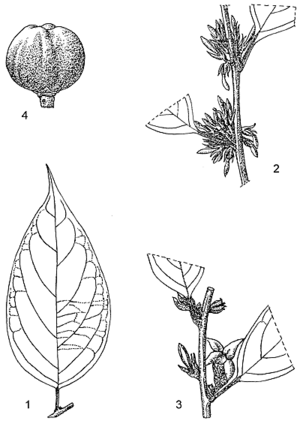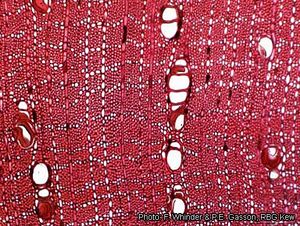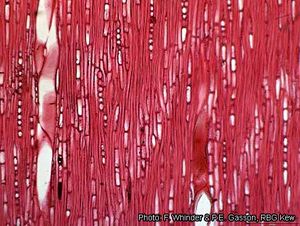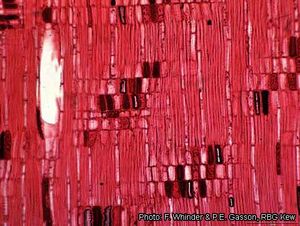Diospyros kamerunensis (PROTA)
Introduction |
| General importance | |
| Geographic coverage Africa | |
| Geographic coverage World | |
| Fruit | |
| Timber | |
| Fibre | |
| Food security | |
Diospyros kamerunensis Gürke
- Protologue: Engl. Bot. Jahrb. 26: 69 (1898).
- Family: Ebenaceae
Vernacular names
- Cameroon ebony, African ebony (En).
Origin and geographic distribution
Diospyros kamerunens is is distributed from Liberia to Ghana and from Cameroon to Gabon.
Uses
The wood of Diospyros kamerunensis is used for posts in house construction, poles, implements, handles, household utensils and drums. It is suitable for heavy flooring, joinery, mine props, ship building, vehicle bodies, sporting goods, toys, novelties, draining boards, carvings, turnery and sliced veneer. The tough stem of saplings is sometimes used as rope. The fruit pulp of fully ripe fruits is edible.
Production and international trade
The wood of Diospyros kamerunensis is mainly used locally and occasionally traded on the international market in mixtures with other ebony woods, often as ‘Cameroon ebony’.
Properties
The heartwood is pinkish when freshly cut, often becoming grey to grey-brown upon drying, and indistinctly demarcated from the paler and wide sapwood. Near the centre of the bole the wood is sometimes blackish. The grain is generally straight, sometimes interlocked, texture usually fine.
The wood is heavy, with a density of about 990 kg/m³ at 12% moisture content, hard and tough. During air drying, it is liable to splitting and twisting, and it is recommended to dry the wood in smaller dimensions. The rates of shrinkage are high. At 12% moisture content, the modulus of rupture is 169 N/mm², modulus of elasticity 15,580 N/mm² and Janka side hardness 14,850 N.
The wood is relatively easy to work in spite of its high density, but the dulling effect on saw teeth and cutting edges may be serious. It planes to a good finish and takes a high polish. Pre-boring is needed for nailing and screwing; the wood holds nails and screws well. The heartwood is quite durable, being resistant to termite attack, but less resistant to pinhole borers and marine borers. The sapwood is not durable and susceptible to Lyctus attack, but it is moderately permeable for preservatives by impregnation. The wood dust may cause dermatitis and irritation to mucous membranes in wood workers.
Description
- Evergreen, dioecious shrub or small tree up to 15(–20) m tall; bole usually straight and slender, up to 30 cm in diameter; bark surface rough, finely fissured, greenish grey, inner bark thin; twigs golden-brownish hairy when young, becoming glabrous.
- Leaves alternate, simple and entire; stipules absent; petiole 1–2 cm long, grooved above, short-hairy; blade lanceolate-elliptical to ovate or oblong-elliptical, 15–20 cm × 5–9 cm, obtuse at base, acuminate at apex, papery or thin-leathery, yellowish short-hairy below especially when young, pinnately veined with 3–7(–8) pairs of lateral veins.
- Inflorescence an axillary fascicle, 3–6(–20)-flowered for male inflorescence, 1–2(–3)-flowered for female one.
- Flowers unisexual, regular; pedicel up to 3 mm long; calyx up to 8 mm long, yellowish red hairy, with tube slightly shorter than the 4 lobes; corolla salver-shaped, c. 2 cm long, fleshy, short-hairy, white or yellowish, with c. 1 cm long tube and 4(–5) lobes c. 1 cm long; male flowers with 12 stamens c. 6 mm long, with very short filaments, hairy at base of anthers; female flowers with 8–12 rudimentary stamens, ovary superior, ovoid, c. 5 mm long, 8(–10)-celled, styles 4(–5).
- Fruit a depressed-globose to ellipsoid berry, up to 4 cm long, sparsely hairy to glabrous, yellow-orange to orange-red when ripe, up to 8(–10)-seeded.
- Seeds c. 3 cm × 2 cm × 1 cm.
- Seedling with epigeal germination.
Other botanical information
Diospyros is a large pantropical genus of about 500 species; in mainland tropical Africa about 90 species occur and several produce valuable timber or edible fruits.
Diospyros monbuttensis
Diospyros monbuttensis Gürke is a shrub or small tree up to 10 m tall with bole up to 40 cm in diameter. It occurs in semi-evergreen forest and gallery forest from Côte d’Ivoire east to the Central African Republic and northern DR Congo. The whitish yellow wood is used for similar purposes as that of Diospyros kamerunensis, but mainly for implements, utensils and handles. The flexible branches are used for game traps. In traditional medicine decoctions of bark and leafy twigs are administered, often in mixtures with other medicinal plants, to treat leprosy, skin affections caused by fungi, jaundice, excessive uterine bleeding and chickenpox.
Diospyros thomasii
Diospyros thomasii Hutch. & Dalziel is a small tree up to 10 m tall, occurring in humid forest in Guinea, Sierra Leone and Liberia, particularly in secondary forest. The wood, which is pinkish when freshly cut, is used for drums and oars. The flexible branches are used for game traps. The sweet fruit pulp is edible. The bark is used to treat diarrhoea.
Anatomy
Wood-anatomical description (IAWA hardwood codes):
- Growth rings: 2: growth ring boundaries indistinct or absent.
- Vessels: 5: wood diffuse-porous; (10: vessels in radial multiples of 4 or more common); 13: simple perforation plates; 22: intervessel pits alternate; 23: shape of alternate pits polygonal; 25: intervessel pits small (4–7 μm); 30: vessel-ray pits with distinct borders; similar to intervessel pits in size and shape throughout the ray cell; 41: mean tangential diameter of vessel lumina 50–100 μm; 47: 5–20 vessels per square millimetre; 58: gums and other deposits in heartwood vessels.
- Tracheids and fibres: 61: fibres with simple to minutely bordered pits; 66: non-septate fibres present; 69: fibres thin- to thick-walled; 70: fibres very thick-walled.
- Axial parenchyma: 77: axial parenchyma diffuse-in-aggregates; 78: axial parenchyma scanty paratracheal; 86: axial parenchyma in narrow bands or lines up to three cells wide; 87: axial parenchyma reticulate; 92: four (3–4) cells per parenchyma strand; 93: eight (5–8) cells per parenchyma strand.
- Rays: 96: rays exclusively uniseriate; 108: body ray cells procumbent with over 4 rows of upright and/or square marginal cells; 109: rays with procumbent, square and upright cells mixed throughout the ray; (113: disjunctive ray parenchyma cell walls present); 115: 4–12 rays per mm; 116: ≥ 12 rays per mm.
- Mineral inclusions: 136: prismatic crystals present; 138: prismatic crystals in procumbent ray cells; 142: prismatic crystals in chambered axial parenchyma cells.
Growth and development
Diospyros kamerunensis is a shade bearer with slow but steady growth. In West Africa, flowering of trees usually occurs in September–October. Fruits ripen about 3 months after flowering.
Ecology
Diospyros kamerunensis is most common in moister evergreen forest, but it can also be found in more dry forest types. It is characteristic for the understorey of undisturbed forest, usually on acid, well-drained soils, but has also been reported from secondary forest.
Propagation and planting
Diospyros kamerunensis may regenerate well under shady conditions in the forest.
Harvesting
Some caution is needed during harvesting operations because logs may have brittle heart.
Handling after harvest
Freshly harvested boles do not float in water and thus cannot be transported by river.
Genetic resources
Although Diospyros kamerunensis does not seem to be abundant in most of its geographical distribution area, it is unlikely to be under threat of genetic erosion. There are no indications of overexploitation.
Prospects
Diospyros kamerunensis will remain useful as a source of wood for local applications, e.g. for poles, implements and utensils. However, prospects as a timber tree of commercial importance for export are poor because of the small size of boles. Chemical and nutritional analyses of the fruits are recommended.
Major references
- Aubréville, A., 1959. La flore forestière de la Côte d’Ivoire. Deuxième édition révisée. Tome troisième. Publication No 15. Centre Technique Forestier Tropical, Nogent-sur-Marne, France. 334 pp.
- Bolza, E. & Keating, W.G., 1972. African timbers: the properties, uses and characteristics of 700 species. Division of Building Research, CSIRO, Melbourne, Australia. 710 pp.
- Burkill, H.M., 1994. The useful plants of West Tropical Africa. 2nd Edition. Volume 2, Families E–I. Royal Botanic Gardens, Kew, Richmond, United Kingdom. 636 pp.
- Irvine, F.R., 1961. Woody plants of Ghana, with special reference to their uses. Oxford University Press, London, United Kingdom. 868 pp.
- Letouzey, R. & White, F., 1970. Ebenaceae. Flore du Cameroun. Volume 11. Muséum National d’Histoire Naturelle, Paris, France. pp. 3–184.
- Oteng-Amoako, A.A. (Editor), 2006. 100 tropical African timber trees from Ghana: tree description and wood identification with notes on distribution, ecology, silviculture, ethnobotany and wood uses. 304 pp.
- Vivien, J. & Faure, J.J., 1996. Fruitiers sauvages d’Afrique: espèces du Cameroun. Ministère Français de la Coopération, Paris, France & CTA, Wageningen, Netherlands. 416 pp.
Other references
- Cooper, G.P. & Record, S.J., 1931. The evergreen forests of Liberia. School of Forestry, Yale University, Bulletin 31, New Haven, United States. 153 pp.
- Hall, J.B. & Swaine, M.D., 1981. Distribution and ecology of vascular plants in a tropical rain forest: forest vegetation of Ghana. W. Junk Publishers, the Hague, Netherlands. 383 pp.
- Hawthorne, W.D., 1995. Ecological profiles of Ghanaian forest trees. Tropical Forestry Papers 29. Oxford Forestry Institute, Department of Plant Sciences, University of Oxford, United Kingdom. 345 pp.
- Hawthorne, W. & Jongkind, C., 2006. Woody plants of western African forests: a guide to the forest trees, shrubs and lianes from Senegal to Ghana. Kew Publishing, Royal Botanic Gardens, Kew, United Kingdom. 1023 pp.
- Letouzey, R. & White, F., 1970. Ebenaceae. Flore du Gabon. Volume 18. Muséum National d’Histoire Naturelle, Paris, France. 189 pp.
- Widodo, S.H., 2001. Crescentia L. In: van Valkenburg, J.L.C.H. & Bunyapraphatsara, N. (Editors). Plant Resources of South-East Asia No 12(2): Medicinal and poisonous plants 2. Backhuys Publishers, Leiden, Netherlands. pp. 191–194.
- White, F., 1963. Ebenaceae. In: Hepper, F.N. (Editor). Flora of West Tropical Africa. Volume 2. 2nd Edition. Crown Agents for Oversea Governments and Administrations, London, United Kingdom. pp. 2–15.
- White, F., 1978. The taxonomy, ecology and chorology of African Ebenaceae I. The Guineo Congolian species. Bulletin du Jardin Botanique National de Belgique 48: 245–358.
Sources of illustration
- Letouzey, R. & White, F., 1970. Ebenaceae. Flore du Cameroun. Volume 11. Muséum National d’Histoire Naturelle, Paris, France. pp. 3–184.
Author(s)
- A.A. Oteng-Amoako, Forestry Research Institute of Ghana (FORIG), University P.O. Box 63, KNUST, Kumasi, Ghana
- E.A. Obeng, Forestry Research Institute of Ghana (FORIG), University P.O. Box 63, KNUST, Kumasi, Ghana
Correct citation of this article
Oteng-Amoako, A.A. & Obeng, E.A., 2011. Diospyros kamerunensis Gürke. [Internet] Record from PROTA4U. Lemmens, R.H.M.J., Louppe, D. & Oteng-Amoako, A.A. (Editors). PROTA (Plant Resources of Tropical Africa / Ressources végétales de l’Afrique tropicale), Wageningen, Netherlands.
Accessed 6 March 2025.
- See the Prota4U database.





